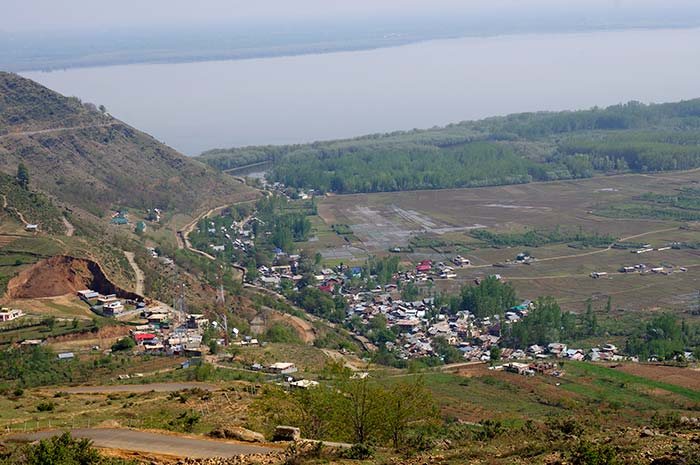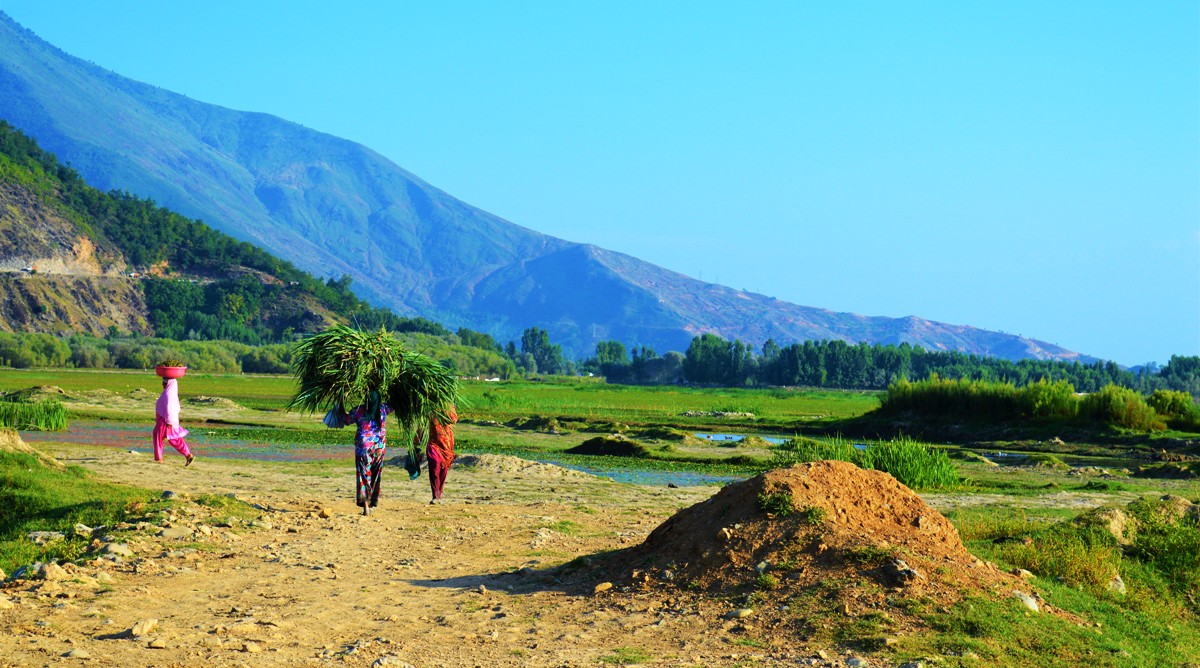Wullar, South Asia’s largest fresh water lake, like other water bodies of Kashmir has suffered tremendous deterioration due to government apathy and public greed. The government is mulling a remedial plan to save it from further destruction. Haroon Mirani reports.

Almost half of Wullar lake and three fourth of its associated marshes has shrunk over the last 100 years with terrible consequences for the lake’s flora and fauna, and Kashmir’s ecology. A state government commissioned study by Wetlands International has suggested immediate action and proposed a five year conservation plan to save the lake.
A Comprehensive Management Action Plan (CMAP) for Wullar prepared by Wetlands International requires an investment of Rs 386.36 crore over a period of five years. The plan envisages the project to break even in just over a decade.
“Within 12 years of implementation, the project (CMAP) would be able to transfer tangible economic benefits, to the local communities, equal to the total investment,” the report says.
The CMAP has been prepared through comprehensive hydrological, ecological and social assessments involving state government departments, community organisations, research institutions and local communities.
The report prepared for the Department of Wildlife protection allocates 72 percent of the overall investment, around 278 crore, for water management, which is critical to rejuvenate the lake. Another 10 percent of the investment will go into catchment area conservation. While sustainable resource development and livelihood improvement has been projected to consume Seven percent of the investment, biodiversity conservation and institutional development have been apportioned Four percent each. Three percent of the investment is earmarked for ecotourism development.
The study identifies the wetlands of Jhelum basin as the lifeline of Kashmir providing ecological and economic security to the entire Kashmir valley through their natural functioning. “By regulating hydrological regimes, these ecosystems provide flood protection as well as water security to the entire basin,” says the report.
Wullar comprised of an area of 217.8 sq kms in 1911 which included 58 sq km of associated marshes. The report estimates present area to be 173 sq km, but revenue records indicate the lake area to be 130 sq km. Overall there was reduction in the lake area by 45 percent mainly due to conversion for agriculture (28 percent) and plantation (17 percent). Further associated marshes were reduced by 70 percent, again due to conversions into agriculture and housing.
The marshes and wetlands of Kashmir acted as a great sponge for Jhelum which held up floodwaters and gradually oozed dry during the winter months, ensuring water security round the year.
However, the capacity and role of Wullar lake to regulate water flows has drastically reduced due to reclamation, siltation and interventions to enhance drainability of water for upstream flood mitigation.
Though the lake continues to build up storage during lean winter months, the high flows during summer goes untapped leading to increased floods and droughts in the valley. This has also enhanced idling period of the river hydropower projects located downstream of Wullar.
The report criticises successive governments for their entire focus of water management in the Jhelum basin having remained on human uses, particularly irrigation and hydropower development, ignoring water allocation for maintenance of biodiversity and overall ecological integrity of the wetlands. “Water is critical to the maintenance of biodiversity and overall wetland ecosystem processes and functions. A balanced approach to allocate water for human uses and ecological requirements is critical to sustainable management of wetlands of the basin, including the Wullar Lake,” says the report.
The report says that one fifth of the water holding capacity of Wullar has been lost over the last three decades due to siltation from degraded catchments and wetland conversions for agriculture and willow plantations.
Direct discharge of solid and liquid waste from the settlements along river Jhelum mainly from Srinagar city and other towns in the upstream have led to degradation of water quality and health hazards to the communities living around Wullar lake.
Decline in resource base and limited opportunities for livelihood diversification have led to poverty and reduced quality of life of communities living around the lake and its catchment areas. The prevalence of poverty between 41 to 52 percent within these communities is quite high compared to the state average of 3.91 percent.
The report has revealed there has been heavy deforestation in the area. In Kyonisu village situated at the banks of the Wullar the forest line has receded by 0.8 km during the last 30 years, whereas the women of nearby Panzgam village trudge two kilometres more to reach the forests.
More than 2000 hectares of pasture land in the higher reaches was identified as severely eroded, 2500 ha as moderately eroded and 4100 ha as under slight erosion.
Degradation of the forest resources has led to the shrinkage in the resource base of the communities. Several minor forest produce of high economic value like the medicinal plants and vegetables like Guchh, Manchren, Ringrish, Wupal Haakh and Vulket are no longer available in the catchment areas.
Around 4600 ha of the area under agriculture around the lake is under severe erosion as these are ploughed across the contours, contributing to high sediment load in the lake. High fertilizer intensity and horticulture lands contribute to overall nutrient enrichment of the water sources, which ultimately flow into Wullar. The water quality of Wullar has deteriorated drastically due to discharge of higher levels of untreated sewage into the adjoining wetlands and river Jhelum. Quarrying has also contributed to silt sedimentation.
Conversion of wetlands which acted as natural reservoirs for regulating flows has resulted in reduction of water holding capacity of the basin.
The aquatic life of Wullar has also come under heavy stress. Thirty-six species of fish were found in Wullar and Jhelum in 1964, but in 2000 researchers could find only 13. Common carp introduced in 1959 has invaded all the meandering rivers and water bodies and has driven out the endemic schizothoracids. Migratory Mahaseer fish was lost due to construction of Mangla dam on River Jhelum in Pakistan administered Kashmir. The fish species was lost as planners of the dam failed to provide a fish ladder that could have allowed migration of the fish for breeding to warmer areas.
Wular lake contributes 23 to 26 percent of total fish production of the state. Estimates put Wullar’s fish production between 3340 to 5150 tonnes per annum. However, the report says that the fish catch has declined from 10544 to 1476 tonnes. The per capita catch has gone down 20 times. Fish and Nadroo have also recorded a decline of 87 percent and 46 percent respectively over the last fifty years.
The report has recommended number of steps for saving Wullar.
The report recommends the removal of the Ningli plantation spread over 27.20 sq km to enhance the water holding capacity. “It will increase water level by at least one metre. Selective dredging at critical areas and improved hydrological connectivity with existing marshes would further help water absorption capacity and further create space for biodiversity enhancement.”
The report says that the implementation of River Jhelum Conservation Plan (JRCP), already approved in principle by the ministry of environment and forests (MoEF), would help in the interception and treatment of sewage. The CMAP also proposes setting up of three sewage treatment plants at Bandipora and adjoining villages besides 18200 low cost sanitation units in 44 peripheral villages. Wetland mediated techniques would help to control diffused sources of pollution in 10 villages on the southern part of the lake.
There are overall 127 settlements around Wullar lake and its catchments located within Baramulla and Bandipora districts. The total population of these settlements as per 2001 census is 460,000. Of this 31 villages comprising of 10964 souls live directly around Wullar. More than half of them live below poverty line (BPL) and more than half of them don’t get drinking water, besides access to roads is much less than state average.
The report has called for treatment of 7436 ha of critically degraded forests in four watersheds. Besides regeneration of 4500 ha of high altitude pasture lands and development of alternate sources of energy.
To protect the biodiversity the report has called for establishment of new bird sanctuaries in the unprotected areas in the stretch of Malangaam-Saderkoot Bala-Ajas as bird sanctuary /community reserves which “would help protection of resident and migratory species from Central Asia”. Additional sites such as Bathi, Shahgund Kuch, Rawkuch, Gouchiri, Gund Jahangir having significant importance in terms of bird population be include as additional bird areas for protection.
The wetlands of Wullar received 1.3 million birds in 2006.

Creation of wildlife sanctuary in the Arin catchment which is the summer habitat of Hangul adjoining Wangat Wildilfe Sanctuary would be critical to reduce man animal conflicts and save the endangered species. Harmukh in the pathway of migratory birds should be also declared as a bird sanctuary for protection of birds.
To enhance the livelihood of the people the report recommends development of recreational facilities such as board walk, nature trails, guided boat rides, angling spots, landscape garden and facilities for aquatic sports in the lake that would be an effective tool for diversification of livelihood opportunities for local communities and generating awareness about the importance of Wullar lake within Jhelum basin.
To help in the dwindling fisheries sector the report recommends sustainable fisheries development through enhancement of fish yield and diversity and classifies it as critical for the livelihood improvement of the communities.
The CMAP puts a lot of emphasis on restoration of Wullar lake for ecosystem conservation and the livelihood security of the communities dependent on the lake resources.















